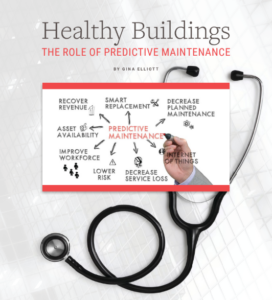This article originally appeared in the November/December 2022 issue of FMJ
by Gina Elliott — The rise of Internet of Things (IoT) technology has added a new dimension to maintenance planning. The data from IoT devices allow facility managers and maintenance personnel to identify problems sooner and resolve them more efficiently. When combined with smart building platforms that provide analytics that inform building performance and conditions, data can guide multiple phases of planned maintenance, but none more so than predictive maintenance.
Analytics are not simply reactive equipment alarms or reports. Analytics are results — specific findings of operational issues presented to the user in clear understandable views. These views explain what the issue is, when it occurred, how long it lasted, the status of all related operating conditions and even the cost impact of the issue. Analytics provide results that show how building systems really operate versus operating assumptions.
Smart building system operators use predictive or data-driven maintenance strategies that incorporate analytics to have efficient maintenance practices. With predictive maintenance, operators can use better, more efficient methods for optimal building operations.
From reactive to preventive to predictive
Building maintenance used to be about correcting issues, otherwise known as reactive, corrective or run-to-failure maintenance. Personnel would fix items when broken and mostly leave them alone when they were functioning as usual.
Unfortunately, this can be costly. According to PRSM’s HVAC Benchmarking Report, reactive service calls after equipment breaks are, on average, three times as expensive as proactive calls. That is an average of around $400 more per call.
Preventive or planned maintenance was introduced in the early 20th century with the advent of the mass production of automobiles. New technologies made equipment more complex, and Henry Ford wanted to plan maintenance to keep breakdowns from occurring on his assembly lines. He not only deployed preventive strategies within his factories, but he also gave preventive maintenance advice to his customers by including time-based maintenance recommendations in the car manuals. Auto manufacturers still use this system today.
Ford’s method was undoubtedly a step up from the reactive approach of the past and innovative for its time, spurring other industries to develop their own preventive maintenance practices. But planning maintenance in this way relies on guessing how much time or usage must occur before maintenance is due.
Doing this with every possible equipment failure is not feasible or cost-effective, so it is limited to likely issues based on run-time or interval time. Preventive maintenance can increase costs by relying on potentially unnecessary inspections and sometimes leading to unnecessary repairs. It also neither predicts equipment degradation based on actual condition and utilization nor will it “prevent” equipment failures.
Predictive maintenance brings innovation to traditional building maintenance by using objective data to more reliably identify issues that may impact future equipment performance, thus avoiding many of the costly problems associated with reactive maintenance. It allows stakeholders to develop a more efficient overall strategy for monitoring and maintaining equipment, comfort and cost.
Benefits of predictive maintenance
Maintenance should be performed when certain indicators show signs of decreasing performance or upcoming failure. This maintenance strategy detects when things go wrong before anyone notices and before repair and operational costs are higher.
Maintenance also pinpoints the root cause of any issues so that it will be much easier to diagnose and fix, reducing second visits. This process identifies design issues, such as incorrect sequence of operations, undersized duct/piping, mismatched components, or inappropriate zoning.
There should also be due diligence prior to dispatch. This includes determining the exact nature of the issue and successfully dispatch the right technician with the right information and parts.
The benefits of predictive maintenance include:
- Reduction in truck rolls
- Decreased total time to resolution
- Increase in first time fix rates
- Reduce retro commissioning with ongoing commissioning
- Reduce overall maintenance costs and improve longevity of equipment
- Lowering risks of major malfunctions
- More straightforward fixes, as problems are caught in the earliest stages
- Minimal downtime, delays and disruption
- Easier budgeting and reduced costs
- Consistent comfort and environment
- Better allocation of maintenance budget and resources
- Longer lifespan of equipment
- Lower maintenance costs with
- Easier compliance with regulatory requirements
- Better equipment performance
- Improved energy efficiency
IoT sensors
In smart buildings, IoT sensor data is essential for predictive maintenance. Smart building management platforms use machine learning (ML) algorithms to analyze equipment and IoT data to identify trends indicating equipment or components status, allowing for targeted maintenance and early intervention to prevent severe and complex problems.
Predictive maintenance is guided by real-time equipment and system data. However, it takes a macro approach, combining data from different environments and conditions to create a big picture that predicts the probability of failures and possible improvements in operational performance.
The problem is that all buildings are unique, and most issues go undetected in routine scheduled maintenance. However, arming a vendor with issues detected via analytics and ML provides a comprehensive plan to fix and maintain equipment showing signs of distress, wear and tear. This reduces the impact of downed equipment including the cost and disruption to FMs and occupants.
When evaluating predictive maintenance, also known as data-driven or condition-based maintenance, versus preventive maintenance, the real differentiator is that real-time, data-driven approach is specific to the actual condition of the equipment. That means manual inspection, replacement and repair occurs only when necessary. Additionally, an ML-driven smart building management platform will produce increasingly accurate and specific predictions as it learns more about the building and its use.
Predictive maintenance anticipates problems based on data, allowing action to be taken to prevent equipment malfunctions. That means no waiting until air quality is compromised or disrupting workplaces to make emergency repairs. Instead, operators address anomalies before they have a chance to affect building health and performance.
Predictive maintenance also goes beyond building systems. Accurate occupancy forecasts allow operators to anticipate each workplace area’s cleaning and sanitation needs and allocate resources accordingly. With occupants more health-focused than ever before, this is essential to ensuring they feel safe in the office.
More on occupancy
Office spaces have traditionally functioned to accommodate full-time workers. The proliferation of hybrid work means workplaces must behave in new ways to meet changing needs and remain effective and safe.
Occupancy forecasting is a powerful tool in predictive maintenance. An intelligent building management platform can predict future occupancy using data gathered from occupancy sensors. This information helps make office square footage more efficient and ensures building automation strategies support a healthy indoor environment, even when occupancy varies drastically.
With occupancy forecasts, a smart building management platform can:
- Automatically adjust HVAC settings to ensure comfort and air quality are maintained at a level sufficient for the number of occupants
- Automatically adjust the lighting to occupant needs
- Eliminate unnecessary heating, cooling, ventilation, and the illumination of unoccupied areas
- Identify areas that need improvement
- Provide valuable information to improve space utilization
Occupancy forecasts can provide valuable data for workplace apps that allow employees to reserve cubicles, conference rooms, desks, offices, and other workspaces. These forecasts are similar to how hotels model daily, monthly, quarterly, and annual occupancy and allocate rooms based on their predictions.
The future is now with predictive maintenance
Analytics and machine learning are the future of building maintenance. A data-driven predictive maintenance plan can revolutionize how buildings function by replacing wasteful routine inspections and providing a meaningful way to prevent equipment degradation. It allows for more proactive monitoring of system health, additional opportunities to optimize performance, and stronger decision-making overall. In addition, it prioritizes the impact on performance, energy and comfort.
Incorporating a predictive maintenance plan means investing in the right smart building platform. A mobile-first platform that features innovative FDD, machine learning, IoT devices, applications, and user-friendly interfaces ensure that teams have the capabilities to take building maintenance to the next level.
Building engineers must ensure building systems and applications operate in harmony in a way that makes sense for the property and tenants. Deep domain expertise in open communication protocols, data integration and system interoperability is a necessary component for designing and implementing a specific solution. Individual needs must be assessed with a partner that understands the complexities of smart buildings to obtain the full benefits of a data-driven, future-focused solution with a practical, predictive maintenance approach.
It is time to take away the guesswork and give FMs greater control.
About the Author
Gina Elliott is chief services officer with Buildings IOT where she oversees the customer onboarding, digital services and customer success. Eliott has been recognized in the industry as Person of the Year nominee (2017), 100 People You Should Know, Women of the Year and 2018 nominee for The Power 100: The Most Powerful Women in the Channel and 2019 winner of ControlTrend’s Small Business Executive of the Year.

